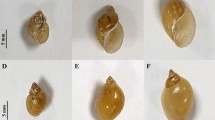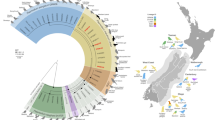Abstract
A new species of Eimeria Schneider, 1875 (Apicomplexa: Eimeriidae) is described from faecal samples of two of three southern short-tailed shrews, Blarina carolinensis (Bachman) (Soricidae) from southeastern Oklahoma, USA. Oöcysts of Eimeria tkachi n. sp. are subspheroidal to ovoidal with a rough-pitted, tan colored, bi-layered wall, measure 16.5 × 15.2 µm, and have a length/width (L/W) ratio of 1.1; both micropyle and oöcyst residuum are absent, but polar granule(s) are present. Sporocysts are ovoidal, 9.5 × 6.5 µm, L/W 1.4; a distinct button-like Stieda body is present, but the sub-Stieda and para-Stieda bodies are absent and the sporocyst residuum is composed of large globules distributed throughout the sporocyst. Sporozoites have a spheroidal anterior refractile body, a subspheroidal posterior refractile body, and one centrally-located nucleus. This is the smallest eimerian described thus far from the Soricidae, the initial description of a coccidian from B. carolinensis, and the first from any shrew from Oklahoma.


Similar content being viewed by others
References
Braun, J. K., Vitt, L. J., Caldwell, J. P., Mares, M. A., & Revelez, M. A. (2011). Mammals from Le Flore County, Oklahoma. Southwestern Naturalist, 56, 410–417.
Bray, D., & Stockley, P. (2005). Coccidian parasite faunas and shrew life history traits: a comparative analysis. In: Merritt, J. F., Churchfield, S., Hutterer, R. & Sheftel, B. I. (Eds) Advances in the Biology of Shrews II, Special Publication 01. Pennsylvania, USA: International Society of Shrew Biologists (ISSB), pp. 349–356.
Caire, W., Tyler, J. D., Glass, B. P., & Mares, M. A. (1989). Mammals of Oklahoma (p. 567). Norman, Oklahoma: University of Oklahoma Press.
Duszynski, D. W., & Upton, S. J. (2000). Coccidia (Apicomplexa: Eimeriidae) of the mammalian order Insectivora. Special Publication of the Museum of Southwestern Biology, 4, 1–67.
Henry, D. P. (1932). Observations on the coccidia of small mammals in California, with descriptions of seven new species. University of California Publications in Zoology, 37, 279–290.
Hertel, L. A., & Duszynski, D. W. (1987a). Coccidian parasites (Apicomplexa: Eimeriidae) from insectivores. III. Seven new species from shrews (Soricidae: Soricinae) from Canada, Japan, and the United States. Journal of Parasitology, 73, 172–183.
Hertel, L. A., & Duszynski, D. W. (1987b). Revision of the name Eimeria palustris Hertel & Duszynski, 1987, from shrews (Sorex spp.). Journal of Parasitology, 73, 1288.
ICZN. (2012). International Commission on Zoological Nomenclature: Amendment of articles 8, 9, 10, 21 and 78 of the International Code of Zoological Nomenclature to expand and refine methods of publication. Zootaxa, 3450, 1–7.
Lynch, A. J., & Duszynski, D. W. (2008). Species of coccidia (Apicomplexa: Eimeriidae) in shrews from Alaska, USA, and northeastern Siberia, Russia, with descriptions of two new species. Journal of Parasitology, 94, 883–888.
McAllister, C. T., & Upton, S. J. (1989). Eimeria cryptotis n. sp. (Apicomplexa: Eimeriidae) from the least shrew, Cryptotis parva (Insectivora: Soricidae), in north-central Texas. Journal of Parasitology, 75, 212–214.
McCay, T. S. (2001). Blarina carolinensis. Mammalian Species, 673, 1–7.
Milek, J. A., & Seville, R. S. (2003). Species of Eimeria and Isospora (Apicomplexa: Eimeriidae) from shrews (Insectivora: Soricidae) in northwestern Wyoming, USA. Comparative Parasitology, 70, 72–77.
NatureServe. (2015). NatureServe Explorer: An online encyclopedia of life [web application]. Version 7.1. NatureServe, Arlington, Virginia. Available http://explorer.natureserve.org. (Accessed: December 13, 2016).
Pfau, R. S., Sasse, D. B., Connior, M. B., & Guenter, I. F. (2011). Occurrence of Blarina brevicauda in Arkansas and notes on the distribution of Blarina carolinensis and Cryptotis parva. Journal of the Arkansas Academy of Science, 65, 61–66.
Reid, F. A. (2006). A field guide to mammals of North America (p. 579). New York: Houghton Mifflin.
Taylor, C. L., & Wilkinson, R. F., Jr. (1988). First record of Sorex longirostris (Soricidae) in Oklahoma. Southwestern Naturalist, 33, 248.
Todd, K. S., Jr., French, R. A., & Levine, N. D. (1986). Eimeria blarinae n. sp. (Protozoa: Apicomplexa) from the least shrew, Blarina brevicauda. Transactions of the American Microscopical Society, 105, 182–184.
Upton, S. J., & McAllister, C. T. (1991). Description of the oöcysts of Eimeria whitakeri n. sp. (Apicomplexa: Eimeriidae) from least shrews, Cryptotis parva (Insectivora: Soricidae). Systematic Parasitology, 20, 59–61.
Wilber, P. G., Duszynski, D. W., Upton, S. J., Seville, R. S., & Corliss, J. O. (1998). A revision of the taxonomy and nomenclature of the Eimeria spp. (Apicomplexa: Eimeriidae) from rodents in the Tribe Marmotini (Sciuridae). Systematic Parasitology, 39, 113–135.
Acknowledgements
We thank Drs. Renn Tumlison (HSU) and Scott L. Gardner and Gabor R. Racz (HWML) for expert curatorial assistance. We also thank Matthew B. Connior (NW Arkansas Community College, Bentonville, Arkansas) for providing faecal samples from B. carolinensis from Arkansas. A scientific collecting permit (number 6477) was provided to C.T.M. by the Oklahoma Department of Wildlife Conservation.
Funding
This study was supported, in part, by a grant from the National Institute of General Medical Sciences (2P20GM103432), National Institutes of Health (NIH) to R.S. Seville. The content is solely the responsibility of the authors and does not necessarily represent the official views of the NIH.
Author information
Authors and Affiliations
Corresponding author
Ethics declarations
Conflict of interest
The authors declare that they have no conflict of interest.
Ethical approval
All applicable institutional, national and international guidelines for the care and use of animals were followed.
Additional information
This article was registered in the Official Register of Zoological Nomenclature (ZooBank) as urn:lsid:zoobank.org:pub:8198DE76-F4FB-4408-B299-3640114F72B2. This article was published as an Online First article on the online publication date shown on this page. The article should be cited by using the doi number. This is the Version of Record.
Rights and permissions
About this article
Cite this article
McAllister, C.T., Seville, R.S. A new eimerian (Apicomplexa: Eimeriidae) from southern short-tailed shrews, Blarina carolinensis (Bachman) (Soricimorpha: Soricidae: Soricinae) from southeastern Oklahoma, USA. Syst Parasitol 94, 711–716 (2017). https://doi.org/10.1007/s11230-017-9730-8
Received:
Accepted:
Published:
Issue Date:
DOI: https://doi.org/10.1007/s11230-017-9730-8




